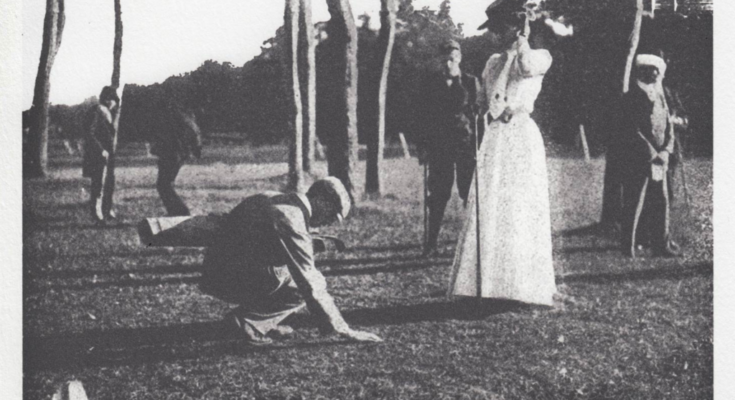Margaret Abbott was the first American female Olympian, but she never knew she was a champion in the 1900 Paris Olympics. This was not confirmed until after her death in 1955.
Abbott was 22 when the French capital hosted the 1900 Summer Olympics. The Games were held as part of the 1900 Exposition Universelle (World’s Fair).
The second modern Olympics was not the spectacular event we know it to be today. There were no opening and closing ceremonies, no athletes standing on podiums, no medals awarded, and no national anthems played. The Olympics were more of a sideshow to the World’s Fair. Nevertheless, 1,226 competitors took part in 19 different sports.
Golf was one of those 19 sports. When the American woman signed on to participate in a women’s golf tournament, she was not aware she would be one of the athletes participating in the 1900 Summer Olympics. She believed the golf tournament was for a Paris championship.
The 1900 Summer Olympics were organized by the same people who organized the World Fair and lasted from May 14th to October 28th. The athletic events were loosely organized and included competitions such as motor racing, ballooning, Basque pelota, tug-of-war, croquet, angling, cricket, kite flying, and pigeon racing. The particular events were not seen again in future Olympics.
At the time, there was no clear distinction as to which sports were part of the Olympics and which were not. As a result, there were some participants who became Olympic champions unbeknownst to them. This was the case with Margaret Abbott.
The Olympian Margaret Abbott
The first American female Olympian was born in Calcutta, India in 1878. Abbott was an infant when her American father, a wealthy merchant, died and her novelist mother, Mary Abbott, took her to Boston. When Margaret was a teenager, the family moved to Chicago, where her mother worked as a literary editor for the Chicago Tribune and Chicago Times-Herald. Mary Abbott got involved in a new sport gaining popularity in 1890s American high society—that was golf. She later introduced the game to her daughter.
At the time, upper class women could not compete in many sports because doctors warned them the physical exertion of sports might cause them permanent damage to their health. Furthermore, women could not expose their legs and were expected to dress conservatively.
Golf, however, did not demand physical exertion or exposed legs, so it was appropriate for upper class women. However, women had to be accompanied by a man on the golf course.
Playing at the Chicago Golf Club, Margaret proved to be a quick learner, winning several local tournaments. As a teenager, she was nearly six feet tall, described in newspaper society pages as a “fierce competitor” with a “classy backswing.” She was predicted to be “one of the best women golfers in the United States.”
Society pages praised the talent of the young woman on the court, describing her as a pioneer for women in sports.
Two American women in turn-of-the-century Paris
Mother and daughter moved to the French capital in 1899. There, Mary wrote a travel guide to Paris for women, and Margaret studied art under the greats Edgar Degas, Auguste Rodin, and Pierre-Auguste Renoir. In 1900, Paris became the center of the world as visitors and athletes flooded the City of Light for the World’s Fair and the 1900 Summer Olympics.
The first modern Olympic Games in Athens in 1896 prohibited the participation of women, as was the case in the ancient Olympics after which they were modeled. Four years later, however, 22 women (out of 1,226 athletes) were permitted to participate in the 1900 Summer Olympics in select sports deemed socially acceptable for women. These included croquet, sailing, rowing, equestrianism, tennis, and golf.
On October 3, 1900, Mary and Margaret Abbott dressed in long sleeves and ankle-length skirts and joined eight other women, American and French, for a nine-hole tournament staged by the exhibition in Compiègne, 50 miles north of Paris. It was the only time in the history of the Olympics that a mother and daughter competed in the same event, and they ended up winning.
After their achievement, Margaret Abbott received an antique Saxon porcelain bowl embellished with gold. It was not clear to her that the competition was part of the Olympics. She believed the golf tournament was connected to the Paris Exposition. The Chicago Tribune reported on the competition, and Abbott wrote about her win to relatives in the United States. However, neither she nor the newspaper were aware she had just become the first American female Olympian.
Gold medals as the traditional prize for Olympic champions were introduced in the 1904 Summer Games.
Abbott returned to the US in 1902 and married humorist and political satirist Finley Peter Dunne. The couple moved to New York, where Abbott continued to play golf. They had three sons and one daughter, all of whom were unaware that their mother had been America’s first female Olympic champion.
Margaret Abbott passed away in 1955, unaware of her pioneering achievement. Decades later, Olympic Games historian Paula Welch uncovered the story of the first female American Olympian golfer after painstaking research and published her findings in the October 1982 issue of The Olympian. She subsequently contacted one of Abbott’s sons, Peter Dunne, who learned for the first time that his mother was the first American female Olympian.



